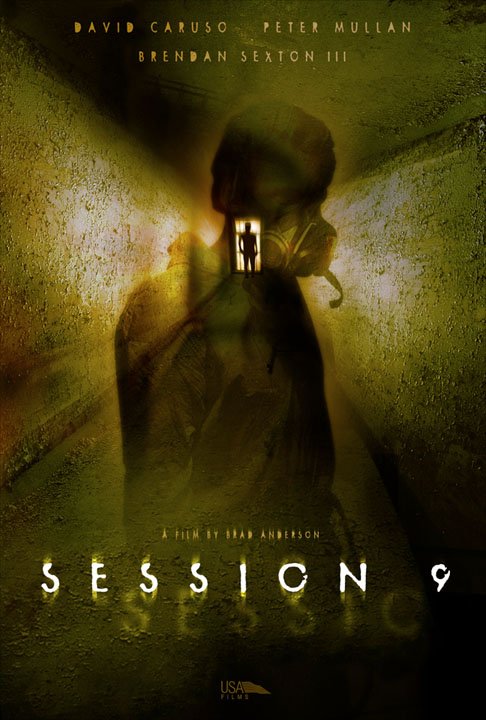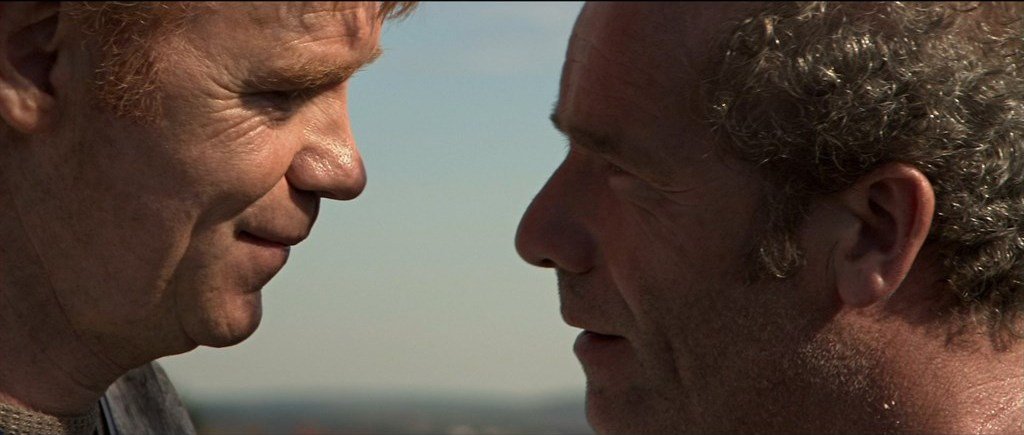SESSION 9: The Human Pain Behind Spectral Haunts
Haunted house movies offer a test for filmmakers. Within the horror genre, they represent the kind of familiar archetype that audiences know by heart and have certain expectations for (they usually want an upscale version of horror that finds a balance between classy and creepy). Thus, the test lies in how prospective filmmakers  deliver on the core audience's expectations while phrasing the delivery in a way that brings out new and interesting nuances that make it worth sitting through another version of this archetype.Session 9 passes this test with flying colors. There's no one moving into an old family home or staying in a creepy house on a dare here. Instead, a group of blue collar men hungry for some work accept the gig to strip out the asbestos from a huge, long-closed mental institution. They're working under a tight deadline to get a big bonus that Gordon (Peter Mullen), the business owner of the group, desperately needs to stay afloat.Also in the group are Phil (David Caruso), Gordon's concerned best pal, law school dropout Mike (co-writer Steven Gevedon) , gleeful sleazeball Hank (Josh Lucas) and naive newbie Jeff (Brendan Sexton III). As the gig gets going, Mike reveals some nasty secrets about why the institution closed down and a chill settles over the group, especially Gordon, who seems to get more rattled with each day. They all begin to squabble and get distracted by odd happenings... but it is this because the place is haunted or they're all beginning to crack under various real-life pressures?The ambiguity suggested by the above synopsis is a key part of what makes Session 9 so effective. Director/co-writer Brad Anderson invests in the human drama as much as he does the horror, taking the time to build an atmosphere of tension within the men and between them that makes us question how much of what we witness is supernatural or psychological. He also uses the institution's history to plant the idea that few things are as scary as losing your mind, which ups the audience's concern level for the ever-more-fragile protagonists.
deliver on the core audience's expectations while phrasing the delivery in a way that brings out new and interesting nuances that make it worth sitting through another version of this archetype.Session 9 passes this test with flying colors. There's no one moving into an old family home or staying in a creepy house on a dare here. Instead, a group of blue collar men hungry for some work accept the gig to strip out the asbestos from a huge, long-closed mental institution. They're working under a tight deadline to get a big bonus that Gordon (Peter Mullen), the business owner of the group, desperately needs to stay afloat.Also in the group are Phil (David Caruso), Gordon's concerned best pal, law school dropout Mike (co-writer Steven Gevedon) , gleeful sleazeball Hank (Josh Lucas) and naive newbie Jeff (Brendan Sexton III). As the gig gets going, Mike reveals some nasty secrets about why the institution closed down and a chill settles over the group, especially Gordon, who seems to get more rattled with each day. They all begin to squabble and get distracted by odd happenings... but it is this because the place is haunted or they're all beginning to crack under various real-life pressures?The ambiguity suggested by the above synopsis is a key part of what makes Session 9 so effective. Director/co-writer Brad Anderson invests in the human drama as much as he does the horror, taking the time to build an atmosphere of tension within the men and between them that makes us question how much of what we witness is supernatural or psychological. He also uses the institution's history to plant the idea that few things are as scary as losing your mind, which ups the audience's concern level for the ever-more-fragile protagonists. Excellent performances across the board help lock that ambiguity in: Mullen is revelatory as a man whose decency is slipping under pressure while Caruso provides a contrast as someone who gets colder and more manipulative as the pressure kicks in. Lucas, Gevedon and Sexton III add their own subtle notes but all get moments where they make us wonder if they are troubled or possessed. There are also colorful cameos by Paul Guilfoyle as the city rep who gives the men their job and indie horror stalwart Larry Fessenden as a worker who joins the crew as things get really intense.However, horror fans shouldn't worry about being cast adrift with Session 9. Anderson shows a steady grasp of horror atmosphere, using stylish, naturally-lit photography by Uta Briesewitz and a subtle but genuinely eerie tone-poem score from Climax Golden Twins to bring out the unnerving, desolate quality of the institution. Using these tools he's able to create a combination of human-scale anxiety and a scary mood that dovetail until they boil over in a nail-biting third act that pays everything off. Anderson is also to be commended for some effective editing in the final stretch, including an inspired final reel that uses intercutting to provide a new spin on events seen earlier in the story.
Excellent performances across the board help lock that ambiguity in: Mullen is revelatory as a man whose decency is slipping under pressure while Caruso provides a contrast as someone who gets colder and more manipulative as the pressure kicks in. Lucas, Gevedon and Sexton III add their own subtle notes but all get moments where they make us wonder if they are troubled or possessed. There are also colorful cameos by Paul Guilfoyle as the city rep who gives the men their job and indie horror stalwart Larry Fessenden as a worker who joins the crew as things get really intense.However, horror fans shouldn't worry about being cast adrift with Session 9. Anderson shows a steady grasp of horror atmosphere, using stylish, naturally-lit photography by Uta Briesewitz and a subtle but genuinely eerie tone-poem score from Climax Golden Twins to bring out the unnerving, desolate quality of the institution. Using these tools he's able to create a combination of human-scale anxiety and a scary mood that dovetail until they boil over in a nail-biting third act that pays everything off. Anderson is also to be commended for some effective editing in the final stretch, including an inspired final reel that uses intercutting to provide a new spin on events seen earlier in the story. In short, Session 9 is one of the great modern haunted house films because it downplays the usual bag of tricks in favor of rooting the horrors in believable human foibles that remind us the spooky things in horror movies are just a metaphor for the turmoil and repressed feelings that haunt the minds of otherwise average people.
In short, Session 9 is one of the great modern haunted house films because it downplays the usual bag of tricks in favor of rooting the horrors in believable human foibles that remind us the spooky things in horror movies are just a metaphor for the turmoil and repressed feelings that haunt the minds of otherwise average people.


